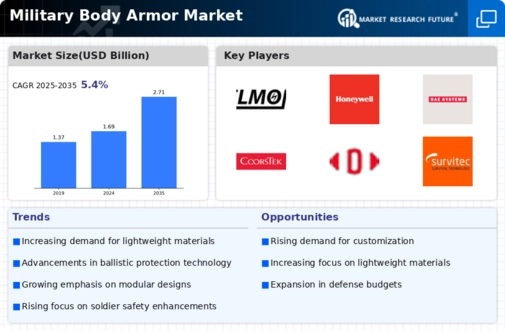Military Body Armor Size
Military Body Armor Market Growth Projections and Opportunities
Military Body Armor Market Size was valued at USD 1.6 billion in 2022. The market for military body armor is expected to expand from USD1.6864 billion in 2023 to USD 2.31208 billion by 2030, with a compound annual growth rate (CAGR) of 5.40% and a rise in innovative approaches that can provide better protection throughout the forecast period (2023 - 2030). Lightweight armor is another outcome of the technology combo, which is the primary market driver boosting market expansion.
The Military Body Armor market is significantly influenced by a diverse array of factors that collectively shape its dynamics and growth. Geopolitical tensions, increased global security threats, and the evolving nature of modern warfare drive the demand for advanced and effective body armor solutions. Military forces worldwide seek protective gear that can mitigate the risks posed by various ballistic and blast threats, contributing to the consistent growth of the military body armor market. As conflicts become more asymmetric, with non-traditional threats prevalent, the need for versatile and lightweight body armor that provides enhanced protection remains a priority for defense forces.
Technological advancements in materials and manufacturing processes play a pivotal role in shaping the Military Body Armor market. Ongoing research and development efforts focus on creating innovative materials, such as advanced ceramics, aramid fibers, and high-performance polymers, to improve the ballistic resistance and overall effectiveness of body armor. The integration of cutting-edge technologies, such as nanotechnology and composite materials, allows for the development of lighter yet more robust armor solutions, addressing the demand for improved mobility without compromising protection.
Military modernization programs and defense budgets significantly impact market dynamics. As defense forces aim to equip their personnel with the latest and most effective protective gear, investments in military body armor become a critical component of broader modernization initiatives. Economic conditions and fluctuations in defense spending may influence the scale and pace of procurement, but the priority placed on the safety and well-being of military personnel maintains the steady demand for advanced body armor solutions.
The evolving threat landscape and the proliferation of small arms and improvised explosive devices (IEDs) contribute to the market's growth. Military body armor must adapt to a wide range of threats, including projectiles of varying calibers, shrapnel, and blast effects. The development of multi-threat protection systems that can address both ballistic and blast threats enhances the versatility and utility of military body armor, making it more effective in diverse operational environments.
Regulatory considerations and compliance with international standards influence the Military Body Armor market. Standards set by organizations such as the National Institute of Justice (NIJ) in the United States and similar bodies in other countries establish performance benchmarks for body armor. Manufacturers must ensure that their products meet or exceed these standards to guarantee the reliability and effectiveness of the armor in real-world scenarios.
The competitive landscape among body armor manufacturers and technology providers is a key market factor. Companies vie for contracts by offering armor solutions with optimal protection, comfort, and durability. Innovations in design, customization options, and the ability to provide tailored solutions for specific military units or mission profiles distinguish leading providers in a competitive market.
Environmental considerations have started to influence the Military Body Armor market, with a growing emphasis on sustainable and eco-friendly materials. Manufacturers are exploring materials and production processes that minimize environmental impact, aligning with broader global initiatives toward sustainability in defense and security technologies.











Leave a Comment